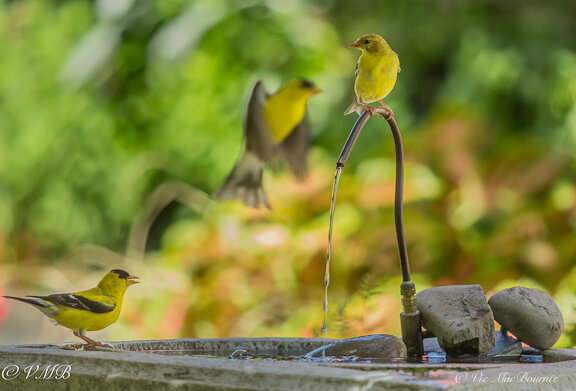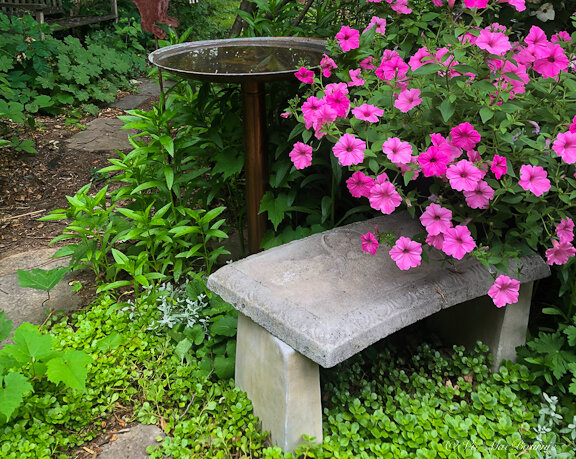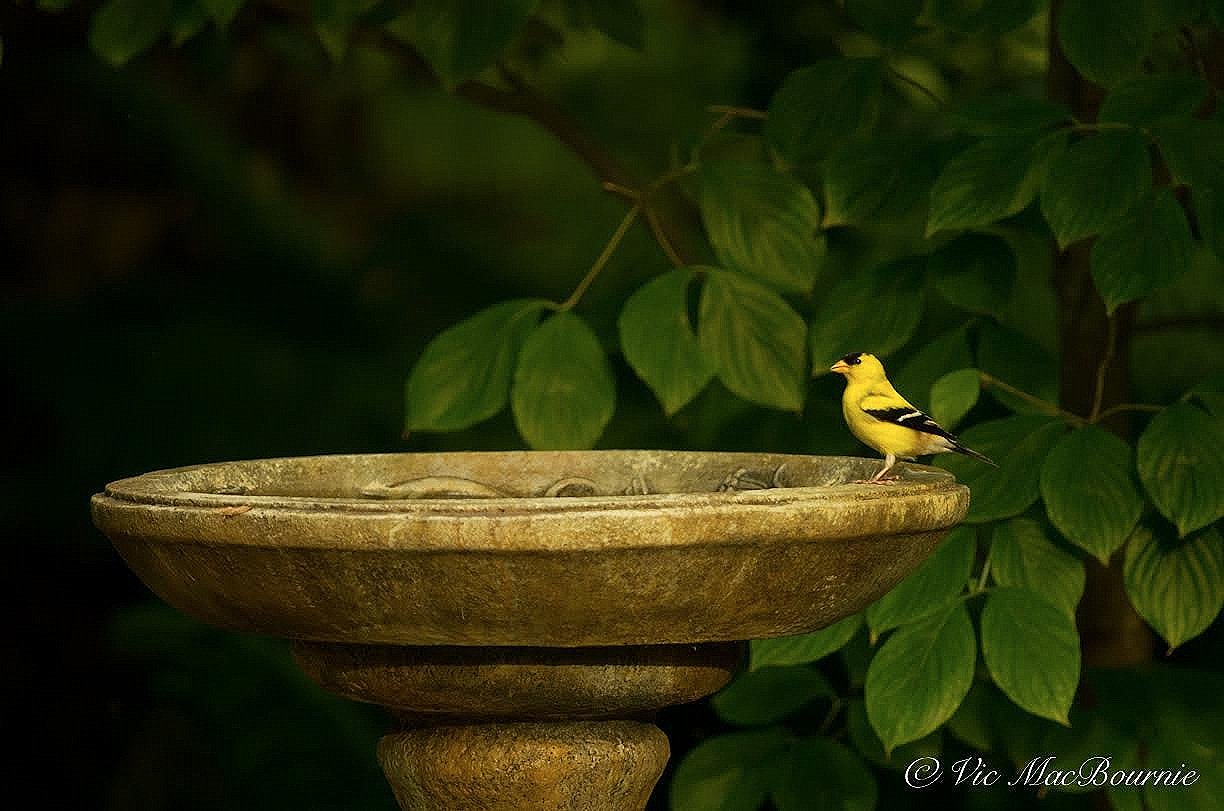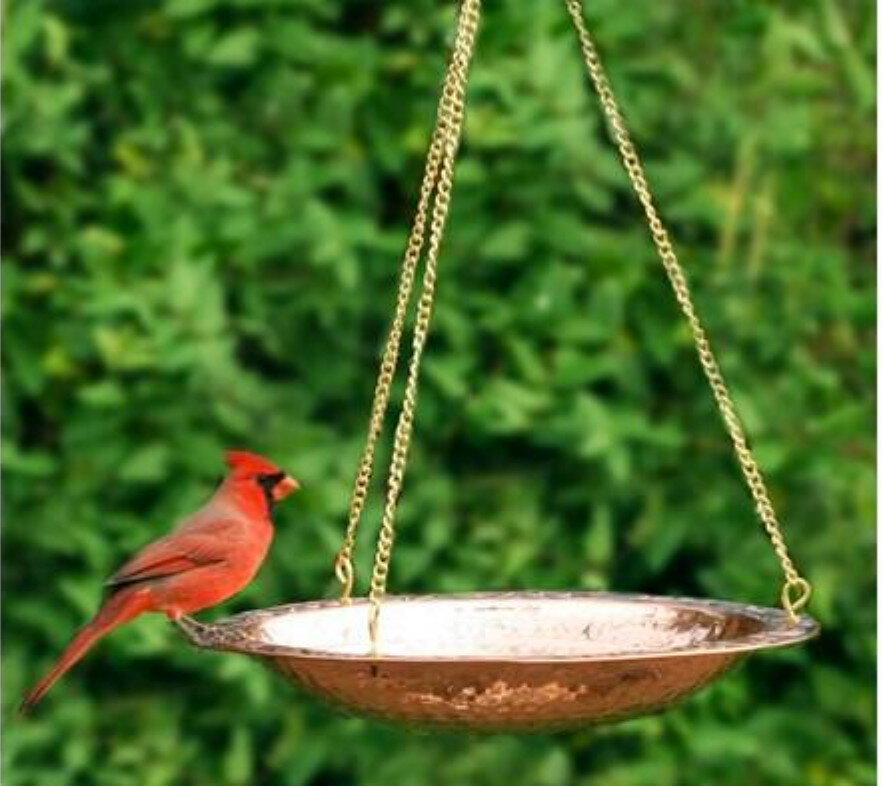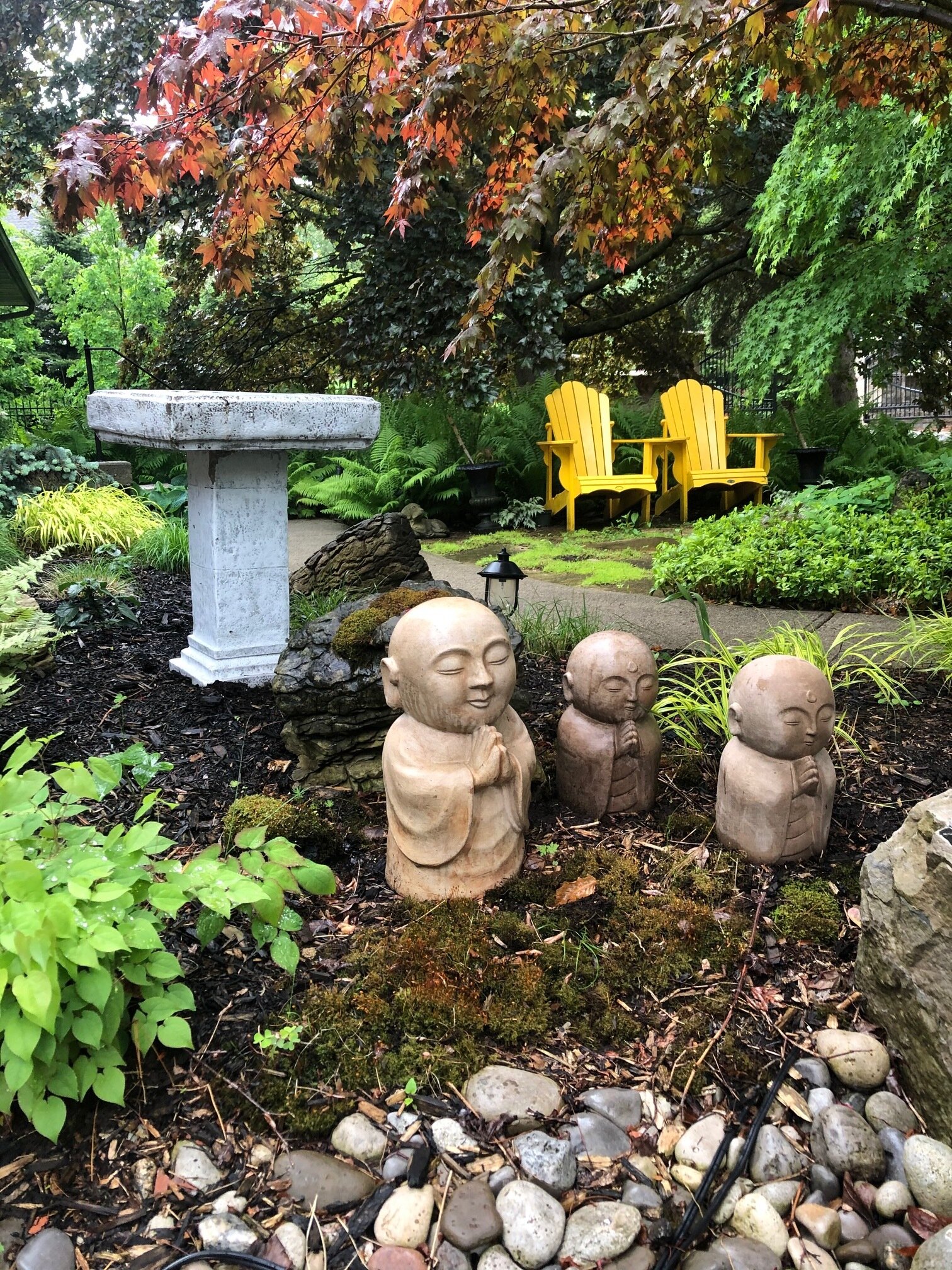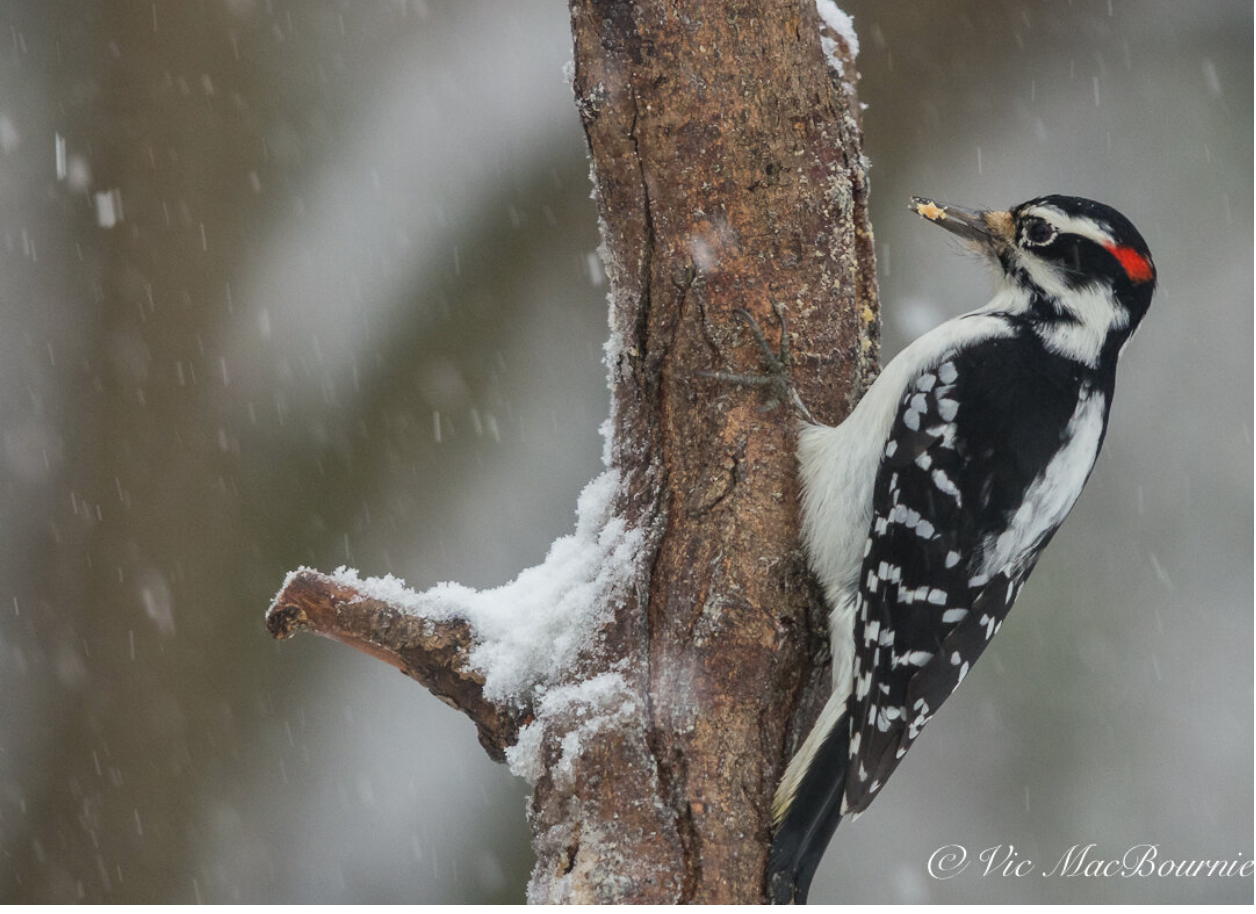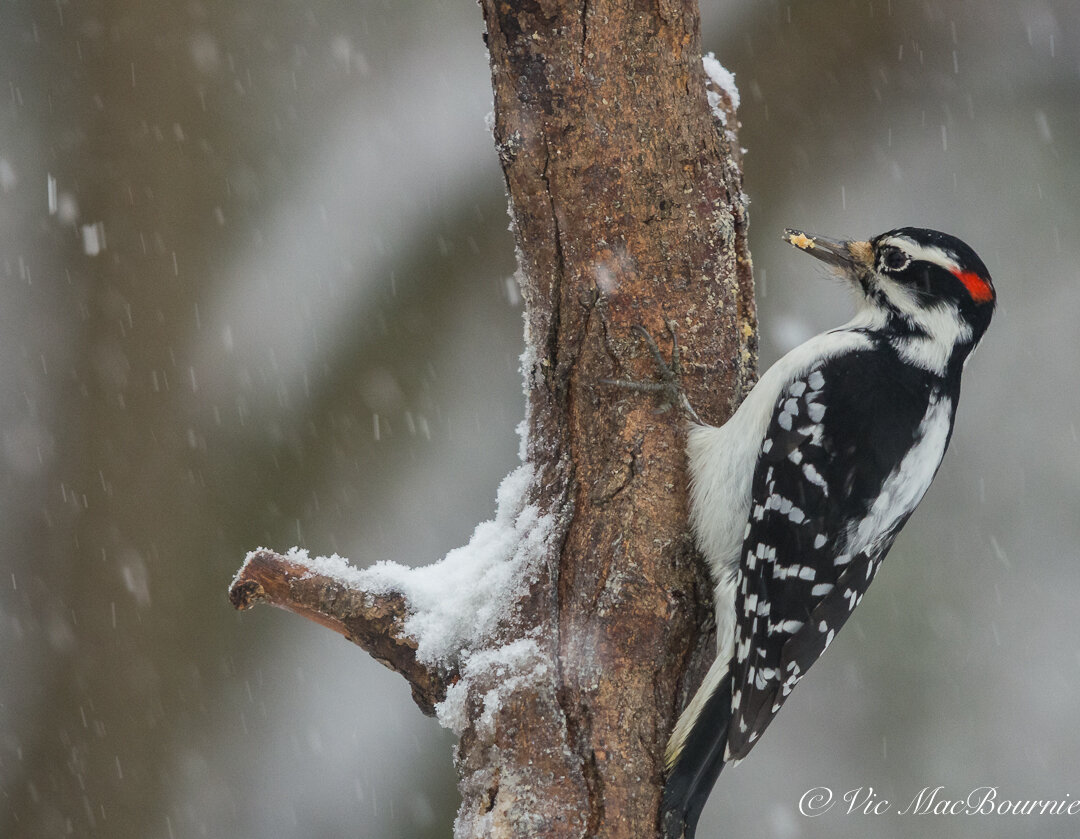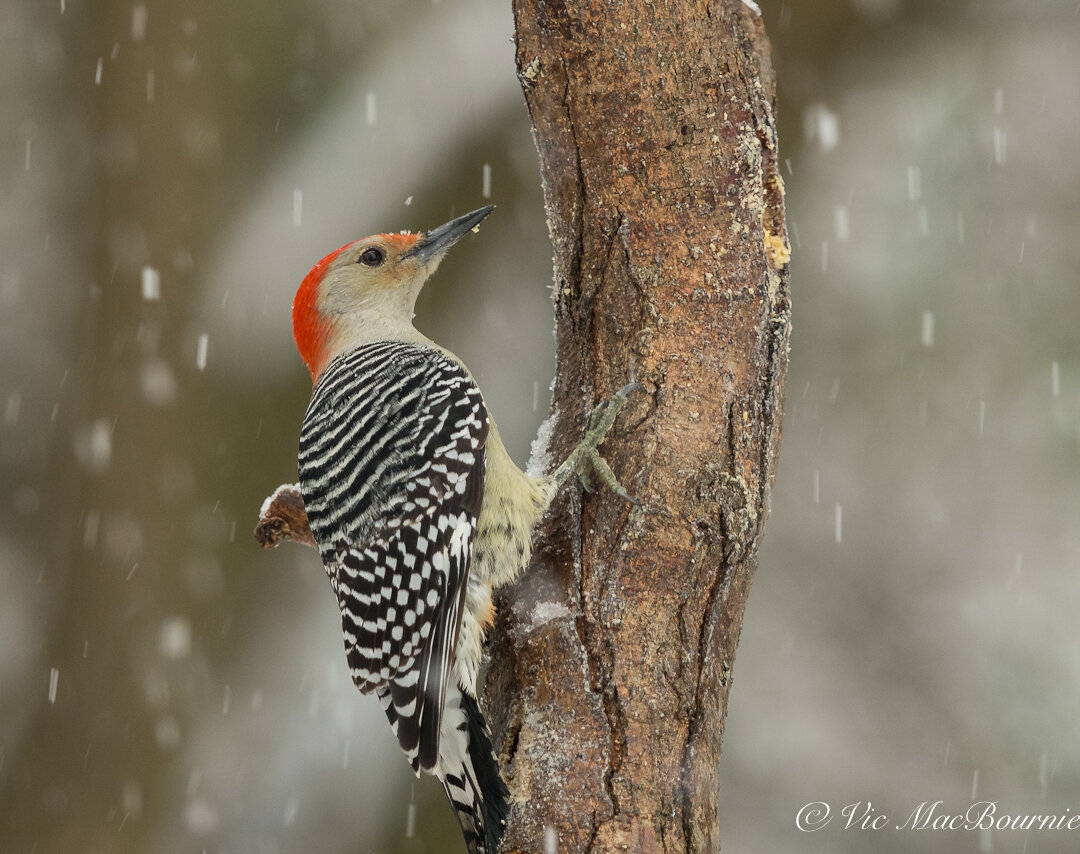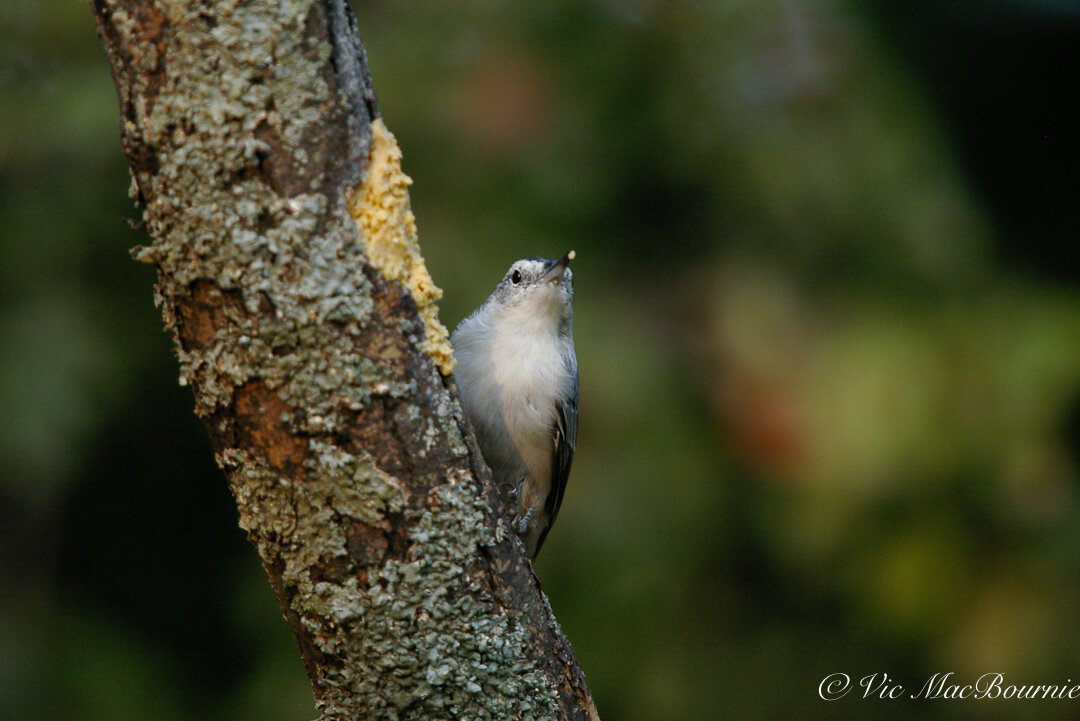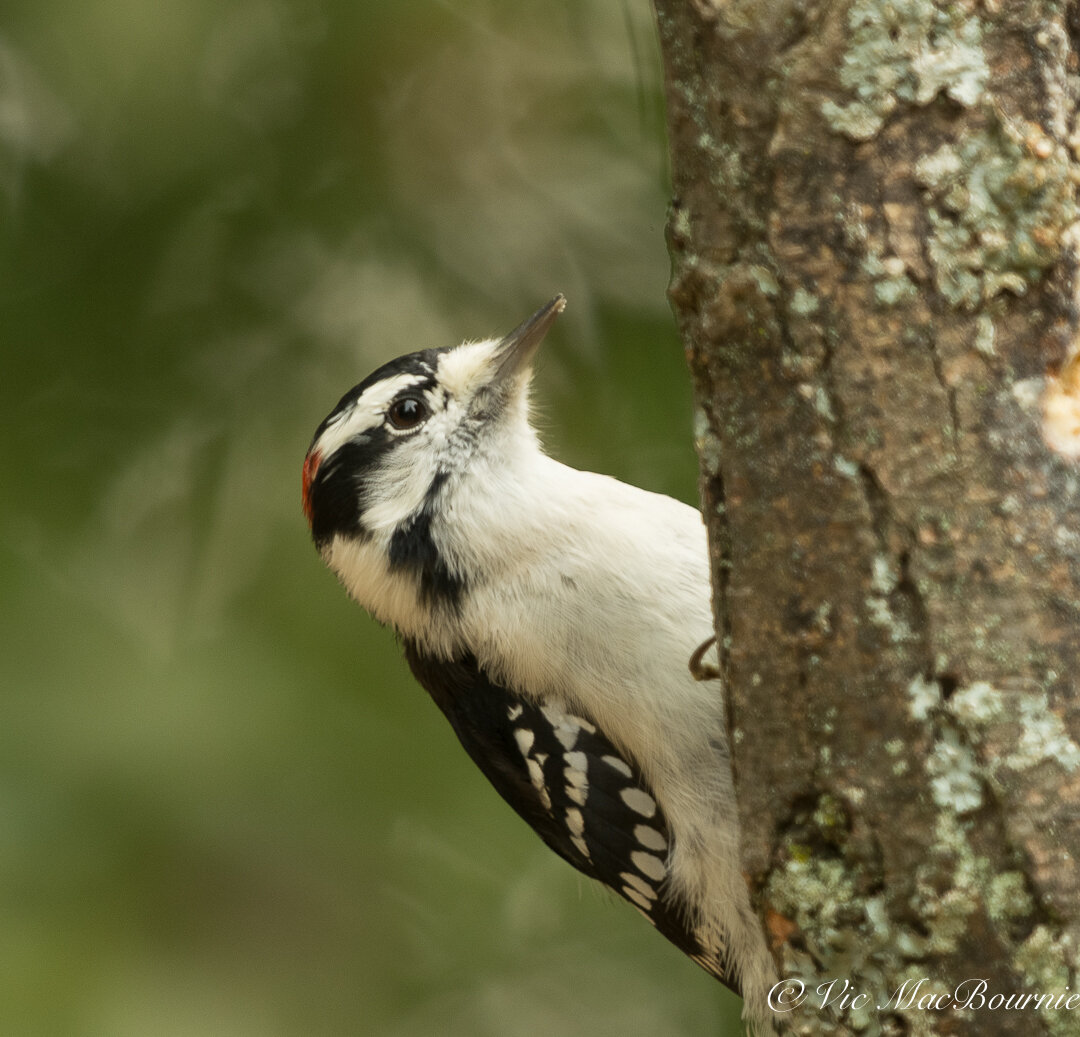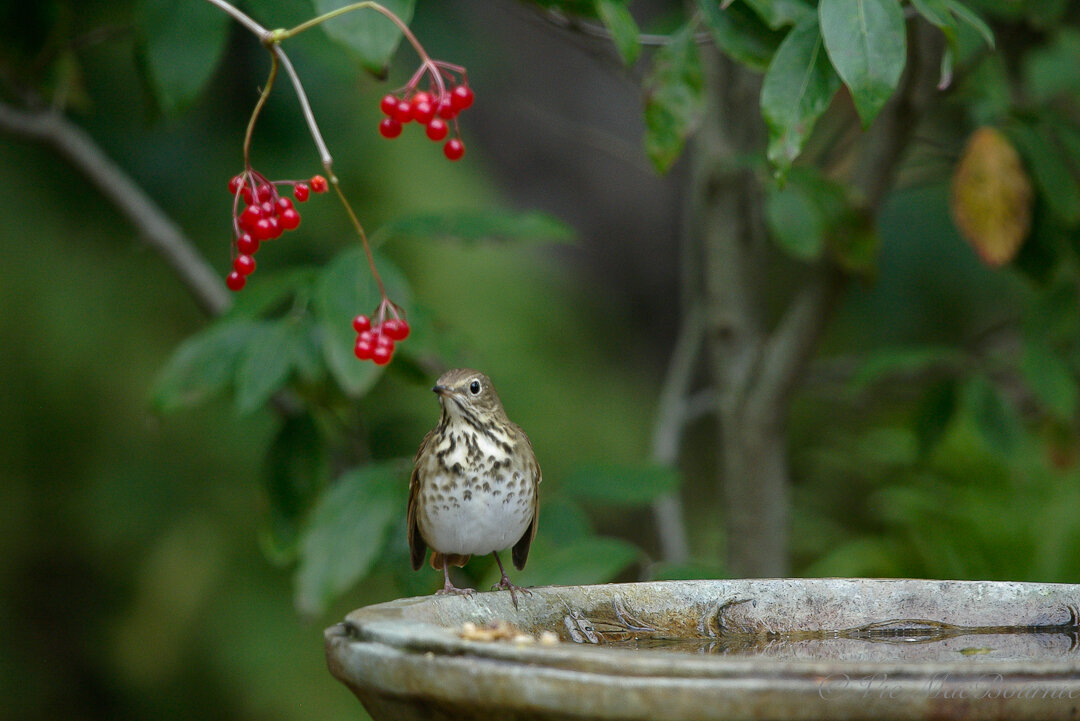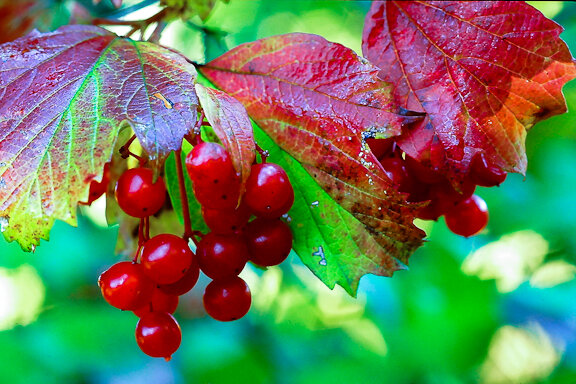What’s the best bird bath?
The best bird bath is the one that backyard birds use the most. But not all bird baths are created equal. The best approach is to have a selection of different bird baths that provide a variety of water sources for birds.
Goldfinches are attracted to the moving water from this DIY fountain.
What bird baths do birds use the most?
The best bird bath for your garden is the one the birds use the most.
It doesn’t have to be pretty, colourful, made of marble or have a three-tiered fountain.
In fact, it can be downright ugly. If the birds like it, then it’s the best for your woodland wildlife garden.
The question that really should be asked is: What bird bath do birds use the most?
The answer to that question is more complicated because birds, like we humans, are all different.
Having several very different bird baths at various levels will attract the largest number of birds to your backyard. This will not only attract a greater variety of birds, it will also limit territorial confrontations and ensure there is always a reliable water source in your garden. But, if I could have only one bird bath, it would be a very large concrete one raised a few feet off the ground, that has a rough surface for the birds to walk on, starts off quite shallow (a half inch) and gradually slopes toward the middle to about two to three inches deep.
I don’t own that bird bath. Instead, I offer the birds a multitude of above ground, hanging, and on-ground water sources of varying sizes where they can drink or bathe to their hearts’ content.
Provide birds with a choice of bird baths
In our front and back gardens, for example, there are usually between 10-12 bird baths on the go at any time during the spring, summer and fall. Most were purchased over the years either new from a store, purchased used from on-line marketplaces or home-made by yours truly.
A copper bird bath is always a good choice both for its aesthetics as well as its antimicrobial benefits.
All of them are very different and appeal to an ever changing variety of birds.
Some include running water. Others are very natural with rocks, pea gravel and moss. Most are concrete, but some are copper, fibreglass, plastic and ceramic. One is only for drinking water.
Do you need that many bird baths?
Absolutely not. But if you hope to attract a variety of birds, a few different bird baths placed strategically in your yard will be a major factor in meeting their varying needs.
If I could have only one bird bath, it would be a very large concrete one raised a few feet off the ground, that has a rough surface for the birds to walk on, starts quite shallow (1-inch) and gradually slopes toward the middle to about two to three inches deep.
Best bird baths for particular bird species
A look at the various bird baths in my garden and how the birds use them is a good way to establish the general hierarchy of backyard bird baths.
By examining how the birds use the various bird baths in my yard, readers can get valuable information about what type of bird baths might be best for their yards.
A favourite for our backyard birds
One of my favourite bird baths is a three-year-old concrete model that sits in a corner of the yard beneath a flowering dogwood and attracts probably the greatest number and variety of birds in our garden. I think its attractiveness to birds is as much about its location in the garden as it is about its construction, but more on locating a bird bath later in the article.
This bird bath has a rough surface to give birds confidence they will not slip. It has a 60-inch circumference and fairly steep sides leading to about a 2.5-inch-deep centre.
It’s not built for smaller birds who shy away from jumping into the depths of the bird bath.
The lip on the bird bath is wide and rough enough that smaller birds will not hesitate to land on it for a drink, but unless the water is quite low in the bird bath (often by the end of the day if used regularly that day) the smaller birds such as chickadees, goldfinches, nuthatches and small sparrows choose other bird baths in the garden.
This bird bath is particularly attractive to larger backyard birds including cardinals, Blue Jays, woodpeckers, thrushes and grackles that visit the bird bath daily both for drinking and bathing.
It’s also short enough that squirrels and chipmunks can jump up to it to get a quick drink if necessary.
Don’t be afraid to move bird baths to a new location
The location of this bird bath is also ideal. It’s in a 1/2 shade location that gets late afternoon and evening sun. It sits nicely right below a flowering dogwood that provides plenty of perching areas for the birds to work their way down to the water when they feel it is safe. There are no hiding places around it that would allow predators to stalk it easily and it’s also in a far corner of the yard that does not get a lot of human traffic.
It may not be possible to place your bird bath(s) in ideal conditions, but don’t hesitate to move bird baths around the yard to look for a spot where the birds feel especially comfortable using it.
Copper bird bath has antibacterial qualities
In another corner of the yard, close to the home, is a large copper bird bath purchased from a couple on Kijiji. The elegant copper bird bath proved too good to turn down despite a hefty price tag for a used bird bath and the hour-long drive to pick it up.
This is by far the largest of the traditional bird baths in our garden, with a 70-inch circumference and a middle depth of just over 2 inches.
It’s a popular choice for birds both big and small as well as a number of chipmunks and red squirrels who visit it regularly throughout the day.
Its close proximity to a garden seat and container planter gives the chipmunks and squirrels easy access to the bird bath that I can clearly see from the comfort of our family room.
The antibacterial qualities of copper is just an added bonus to its large water reservoir, gradual slope to the middle and it’s two-inch central depth. Its small rounded lip makes it easy for small birds to grasp for a quick drink and its depth is a favourite for our cardinals to use as their nightly bathing spot.
The copper bird bath’s biggest downfall is the fact that it, like any metal bird bath, can quickly overheat the water if left out in the sun for any given time. Even in the shade, the water can heat up on particularly hot days.
Our copper bird bath is in a shady area of the garden, but more importantly, it is very close to the hose and gets a cold-water top up on most days, especially on particularly hot ones.
Any metallic bird bath should be placed in a shady spot where it gets as little sun as possible to prevent the water from overheating.
A perfect solution is to purchase a copper hanging birdbath that you can tuck in a shady spot under a large tree, preferably near your favourite sitting area. This copper bird bath (see below) from Gardener’s Supply might be the perfect addition to your garden.
If your favourite place to watch the birds is on your deck, the deck mounted bird bath, also from Gardener’s Supply should do the trick.
This copper bird bath from Gardener’s Supply is ideal for hanging in a tree near your favouring sitting place.
Benefits of a copper bird bath
Copper’s malleability has made it a popular building material dating back close to 10,000 years where it has been used to make tools, eating utensils and other important household objects.
If a deck is your favourite hangout spot to watch birds, a copper birdbath that attaches directly to the deck makes not only enjoying the birds easy, but filling and cleaning the bird bath is simple too.
Today, whether in its pure state or combined with other metals to create alloys such as brass or bronze, it is primarily used to create decorative indoor and outdoor objects that age gracefully, especially in the garden where it takes on a beautiful patina over time.
Often overlooked is copper’s anti-algae and anti-bacteria qualities that make it the perfect choice for bird baths and bird feeders. Easy to clean, with its own limited self-sterilizing qualities, copper bird baths should get high marks when considering the purchase of a new bird bath. Their longevity, antibacterial qualities and natural good looks as they age in the garden makes them a fine investment if you are looking for both a piece of art and highly functional bird bath for your garden.
Although a copper bird bath seems like a perfect addition to any garden, besides the high purchase cost, they also tend to be quite light in comparison to a concrete or resin bird bath and as a result are easily damaged if they are knocked over onto a hard surface. When placing your bird bath, try to keep it away from a concrete pathway or patio where it would likely be damaged if it fell over or was knocked over.
If purchasing an expensive copper birdbath does not interest you, you can take advantage of the antibacterial qualities of copper by simply stripping copper wiring of its plastic sheathing, wrapping it around an object and placing it in the birdbath. Try tucking it under a couple of rocks to keep it hidden and stop any curious mammals or crows from carrying it off.
A rock placed in the bird bath gives smaller birds a safe and familiar landing place to drink from.
Add a solar fountain
I recently picked up two smaller copper-look bird baths on line that work well near our patio. I suspect they might have been for sale at a good price because the previous owners didn’t have much luck attracting birds with them.
At first glance they looked awfully deep and their steep, metal sides likely scared away any birds.
Perfect, I thought when I picked them up. A few modifications later, and our two very attractive bird baths would work well for both aesthetics and, more importantly, our backyard birds.
To solve the problem, a large rock was simply placed in the middle of the bird bath. The rock is large enough to protrude out of the water enough to give smaller birds a comfortable and safe landing spot to stop for a quick drink or dip into the bird bath.
The other bird bath was a perfect candidate for my DIY Solar drip turned fountain. Because the centre was so deep, I was able to bury the solar pump under the flat stone that is part of the drip. The combination works perfectly with the moving water attracting birds and the flat rocks giving them safe access to the water.
If you are looking to add a solar pump to a bird bath, it’s best to get a deeper one so the pump is in deep water even if the birds splash a fair amount of water out of the bird bath.
When birds think square is cool
Our square bird bath in the Japanese-inspired garden.
Let’s face it, everyone wants nice things in their garden.
If it can double as a piece of art, it’s even more valuable. That’s how I feel about our square, super heavy bird bath that graces our front Japanese-style garden.
It fits perfectly into the Japanese garden aesthetic with its simple straight lines, heavy square pedestal stand and equally heavy square top. The entire bird bath is painted white with an acrylic paint that gives it a sophisticated look rather than the rustic one often associated with traditional cement bird baths.
I love its looks, but more importantly, so do the birds – especially the Goldfinches that visit it daily on multiple occasions. But they are not alone, our neighbourhood Robins also have a soft spot for this bird bath as well.
Very different birds – one very large and aggressive while taking a bath, the other quite small and shy – attracted to the same bird bath.
What’s the story here?
It turns out that this bird bath has a huge square rim (3-inches wide) surrounding the round and rather deep centre pool (1.5- to 2.5-inches deep) that has a natural shallower spot in the middle. The robins hop right in and fully enjoy themselves in the deeper water, while the Goldfinches stay on the large brim and easily sip at the water’s edge. Small, decorative indentations (leaf motif) are often filled with water and allow the Goldfinches to sip from them in complete safety.
Other birds, especially Cardinals, also visit the Japanese-style bird bath that sits nicely in the shade under the perching branches of a mature Japanese Maple.
Nearby, is a massive boulder with a small natural pool in it that fills with water after a heavy rain. On my daily watering rounds, I always fill the small natural pool after filling the bird bath. The small pool is a favourite for small birds but it’s so small and shallow that it is not a reliable source of water. The nearby bird bath creates that all important reliable source of water for the birds.
Tiny concrete bird bath is a small-bird favourite
Since we are still in the front garden, let’s talk about the tiny concrete bird bath that has become a real favourite for small birds, and chipmunks winter, summer, spring and fall.
It’s been in the same spot for probably eight years, is a mere 1.5 inches-deep when it is brimming full (almost never) and measures only 22 inches in circumference. But the Goldfinches, Chipping sparrows, chickadees and chipmunks gravitate to it daily. In fact, keeping it full of water is almost a full-time job during the heat of the summer.
Why do birds like this bird bath so much?
The key to the success of the tiny bird bath is the fact that small birds feel extremely safe using it. It’s only about 14 inches off the ground, has a rough surface and is shallow enough that they can jump right in and get down and dirty (or should I say clean).
It’s surrounded by naturalistic gardens and sits in the shade of the canopy of three mature trees: A very large Crimson Maple, a good-sized Japanese Maple and a large single-trunk Serviceberry.
With good vision all around, little threat from above, and an abundance of quick escape hatches this bird bath has become a safe, quiet place that creates a comfort level that these small birds like to take advantage of whenever possible.
Two large, moss-covered limestone boulders provide both the birds and the chipmunks with a perfect place to preen after their baths. It’s not uncommon to see them taking turns flitting from the bird bath to the rocks and back again. Our front garden is also a quiet place, away from a lot of human activity making the bird bath even more desirable for shy birds.
On-ground water sources are a favourite
Ever seen a flock of birds having the time of their life in a puddle after a storm? It’s often a dirty puddle by the side of the road with a massive lake right next to it and they choose the puddle. Why?
It’s all about safety and easy access for these smaller birds.
And that’s the beauty of small, shallow on-ground water features sprinkled throughout the garden.
These water sources could be simple – an old lidless piece of tupperware – or more involved like concrete formed into a leaf pattern. Either way, the birds, mammals, amphibians and reptiles will thank you for providing much needed water at ground level where they have easy access to it.
Add a bubbling rock
A small, solar-powered bubbling rock is one of the most heavily used water sources in our woodland garden, but it’s not what you may think.
When I first installed the bubbling rock, I imagined birds flocking to the bubbling end sipping and splashing about and just having the time of their lives.
That didn’t really happen. Sure, on occasion a bird will perch on the rock and sip or frolic about in the bubbling end of the rock, but it’s more likely that the birds, chipmunks and squirrels drink from the water reservoir at the bottom of the bubbling rock.
It’s common knowledge that birds are attracted to moving water whether it’s a simple drip or the steady flow from a bubbling rock, but like anything, the reliability of that water is of prime importance. I believe that because the solar fountain is only on during sunny periods, the bubbling water is less reliable than the water in the reservoir and the birds and animals have gotten used to going to the reliable source.
Keep that in mind the next time you let your bird baths go dry for an extended period of time.
Nevertheless, between the reservoir and the bubbler, it’s a popular spot in our garden.
Concrete leaf and a moose’s ears prove popular
We fell in love with it the minute we saw it, paid too much for it, but have enjoyed it for years. A large rhubarb leaf molded into a concrete on-ground bird bath that needs to be filled daily and holds a tiny amount of water.
But I don’t know what the chipping sparrows would do these days without it. They are the leaf’s biggest fans in the bird world.
In the mammal world, the leaf has become a hangout for one of our friendly chipmunk families that decided the water-filled leaf made for the perfect backyard swimming pool going so far as to dig through and around large river rock and pea gravel to locate their back door right next to the leaf.
Living their best life among the soft sedum and rocky outcrop surrounding their backyard pool I guess.
In another area of the garden is Bruce (Springsteen) the moose with large ears that are actually quite deep water reservoirs. My fondest memory of Bruce the moose, was the time a mother Oriole brought her entire brood to bathe in Bruce’s oversized ears.
It was quite the sight.
The two ears act as water reservoirs. The ears are not big. In fact, the young Orioles had to take turns jumping into the ears, but once they got in they found the water quite deep (about 3 inches). No worries though. The tight confines ensured the little birds were not going to slip or fall over. Maybe that’s why mom brought them in to see Bruce.
Anyway, everyone had a great time playing in Bruce’s ears for about 10 minutes before flying off.
Hanging bird bath at home in a tree
If you are like me and like to watch the birds up close during your morning coffee, a hanging bird bath is the best option. Ours sits in a large yellow magnolia that actually overhangs our patio. In the mornings, the boisterous Carolina wrens and Chickadees use it for a quick morning bath or drink and I get to watch them between sips of coffee.
Our hanging bird bath is from Lee Valley and sports a very shallow (1-inch in the deepest part) ceramic bowl with a terra cotta edge to provide grip for the small birds. It needs regular filling, so placing it in a shady, easily accessible spot allows you to keep your eye on its water levels throughout the day.
Because it is so shallow, by placing a layer of pea gravel in it, butterflies, dragonflies and other insects may also become regular visitors.
In conclusion (not all bird baths are created equal)
Bird baths are no different than most things in life – a single solution is rarely the best.
Success will be more likely if you incorporate a few different bird baths to attract different types of birds. Large deep ones for big birds like Jays, Cardinals, Grackles, Orioles even the neighbourhood crows. Smaller, shallow birdbaths for Chickadees, goldfinches, nuthatches, sparrows, house and purple finches. On-ground bird baths for shy birds that prefer to bathe at ground level.
I have yet to mention our three massive garden water bowls that sit on the ground between 8-12 inches high. On more than a few occasions, I have seen a large hawk use one of the bowls as a bird bath.
Generally speaking the bigger and deeper the bird bath, the bigger the birds will be who use them.
A solar fountain is an excellent addition to any bird bath. Use one with a gentle spray nozzle to provide hummingbirds with an opportunity to cool off by flying through the spray.
Remember that bird baths don’t have to be expensive.
Birds aren’t looking for pretty. They are way to busy surviving.
Give them a helping hand and you’ll be rewarded ten times over.
Providing birds with water is vitally important, but don’t forget to provide food as well.
While I get great enjoyment from my bird feeding stations, providing natural food sources to our feathered friends is always the goal we should aspire to in our gardens. I have written a comprehensive post on feeding birds naturally. You can read about it here.
As an affiliate marketer with Amazon or other marketing companies, I earn money from qualifying purchases.
Bark butter and DIY bird feeders
The combination of a DIY feeder and WBU’s Bark Butter is an irresistible draw for more than 150 species of birds. If attracting woodpeckers, nuthatches and chickadees along with warblers sounds good, check out this simple and easy to make feeder and food combination.
Natural feeder is irresistible to 152 species of birds
Combining Bark Butter with a DIY bird feeder has become my favourite combination for attracting woodpeckers, nuthatches and chickadees to my wildlife, woodland garden.
It has also quickly become my favourite feeder combo to photograph birds in a natural setting.
So if you are like me and love either photographing backyard birds, or simply watching woodpeckers, nuthatches and other suet-loving garden visitors as they peck away gathering food for the winter, then you will love the simplicity of creating this DIY branch feeder. The feeders are so easy to make and appreciated by out feathered friends that I’ve already made two and plan on making many more in the near future.
But before digging in on how to make the DIY feeder let’s talk a little about Wild Birds Unlimited Bark Butter.
There are other spreadable-suet products available that might suit your needs. I just can’t speak to them. I do plan to order some of these products from Amazon and will report back.
A woodpecker removes a piece of Bark Butter from the DIY branch feeder.
What’s Bark Butter?
Bark Butter is a spreadable suet-peanut butter and corn blend that can be easily spread on a rough surface like tree bark or stuffed into holes or small crevices that are easily accessible to many birds. It is especially accessible to those birds with long beaks that can reach into cracks and areas where squirrels may have difficulty reaching. It is sold, in many different forms, through Wild Birds Unlimited stores and on line throughout Canada and the United States. The formula for Jim’s Birdacious Bark Butter is said to be created by Jim Carpenter, founder of Wild Birds Unlimited. It is advertised as a food source that attracts a greater variety of birds than any other food source including regular suet.
This Flicker is working one of the many Bark Butter pockets in the DIY branch feeder.
I can’t verify the claims that it attracts more than 152 species of birds, but I can verify that this stuff is a joy to use. Its peanut butter base makes handling it enjoyable. In fact, I mostly just scoop it out of its plastic container using my hands and stuff it into the holes I’ve drilled into the DIY feeder tree branch. Any access bark butter that gets on my hand is simply rubbed into the crevices of the branch’s bark.
Getting back to those 152 different species that Bark Butter is said to attract. I have no doubts that the claims are true that Bark Butter attracts everything from woodpeckers like Flickers, Downies, Hairy and red-breasted woodpeckers, to Brown Creepers, Chickadees, Jays and even warblers. As many know, attracting warblers to our gardens is not always easy. Anything that brings warblers into the yard is a good thing and, since Warblers are big insect eaters, the bark bits with insects would be a good choice to attract them.
Bark Butter is not inexpensive so care should be taken to use it wisely and do everything possible to keep squirrels and other mammals from feasting on it.
Although it is recommended to be spread on tree bark, if squirrels discover it before the birds, there’s a good chance they’ll devour most of it before the birds get to it.
The DIY feeder helps solve this problem. Because it can be hung from a feeding station complete with squirrel baffles and placed is an area of your garden that makes access difficult for raccoons, squirrels and other garden critters, it’s easy to maximize the benefits of the butter.
As an experiment, I have created two of these feeders. One is hanging off the feeding station and therefore protected from squirrels. The other feeder is part of a large tree branch that has been dug into the ground and allows easy access to red and grey squirrels among other backyard wildlife critters who discover it.
A Nuthatch feasts on Bark Butter at the lichen-covered DIY branch feeder.
As a result of the experiment, I can attest to squirrels’ love of Bark Butter and the importance of making access difficult for them. Once loaded up, the Bark Butter feeder on the feeding station remains available to the birds for several days, while the branch feeder is more or less devoured in a day or two. I suppose using the hot pepper mix is appropriate in this circumstance to keep squirrels away, but after my fair share of hot wings, I’m not a fan of teaching the squirrels a hard-earned lesson.
In the end, I like both feeders. If saving money is important to you, however, it’s probably wise to make it difficult for squirrels to get access to your DIY feeders.
The bark butter is available in plastic tubs in both regular and a hot pepper blend that helps detract squirrels from feasting on the rather expensive feed. It’s also available in a Bugs and Bits blend, which incorporates small pellets of bark butter together with insect parts including meal worms. The same pellet-shaped Bark Butter Bits are available without the insects and with hot pepper. There is also Bark Butter quickbites and a large no-melt suet cyclinder. Both are available in regular and hot pepper.
Be aware that some Wild Birds Unlimited locations choose not to sell the hot pepper Bark Butter.
For more on Building your Garden on a Budget go here.
While I get great enjoyment from my bird feeding stations, providing natural food sources to our feathered friends is always the goal we should aspire to in our gardens. I have written a comprehensive post on feeding birds naturally. You can read about it here.
Simple, easy-to-create DIY feeders
There are many different ways to use Bark Butter. One of the simplest ways is to gather pine cones from the garden and smother them with the bark butter. These can be hung from tree branches throughout the garden especially during or just before a snowfall.
But my favourite method is to use a one- or two-foot branch cut from or left over from a tree pruning, either from your own tree or a neighbours’. My feeders are a little thicker than a man’s wrist, but larger, heavier branches can be used for larger woodpeckers like the Pileated woodpecker.
These feeders are so simple to make that the process is almost not worth describing. But here is a simple description of the process.
• Drill a hole through the branch maybe an inch or two down from an end to insert string or preferably wire, which will be used to hang the feeder.
• Then, using a larger drill bit, start drilling several pockets or holes in the branch at regular intervals.
• If there is a side branch, leave some of it to act as a small perch for the birds. Then drill a hole above the perch to act as a convenient location for birds to get easy access to the Bark Butter.
• I use a combination of drilled pockets that go half way into the branch, full holes drilled right through the branch to provide birds with different length beaks access to the butter.
• Once the wire is attached and the Bark Butter applied, you can hang the feeder. Leave room around the feeder to give visitors access from all sides.
• Refilling the tree branch with suet is just a matter of taking a clump of the Bark Butter and stuffing it into the holes. I do it with my hands but you could use an old spoon. Wild Birds Unlimited says to use a fork for the final application because the rungs leave a criss-cross pattern in the butter that birds can easily pick off and eat.
Create a free-standing feeder for all garden visitors
• Our other Bark Butter feeder is nothing but a larger 8- to 9-foot branch partially buried into the ground a couple of feet.
• Once stabilized in the ground, drill several holes and pockets in the branch at various heights to provide birds with several feeding areas up and down the branch.
• Smaller holes can be drilled into the branch to insert perches for birds or long screws to hang smaller feeders from. This is an ideal spot to add Bark Butter-infused pine cones.
• I like to fill this bird feeder an hour or two before going out to photograph the birds to give me another potential photo location.
Branch feeders are ideal photographic stages
This larger branch has become a favourite location for birds and squirrels who enjoy taking up a position on top to scan the garden. It has only been up for about eight months and I’m sill waiting for a large hawk or owl to discover it and use it as a hunting perch.
But I’m confident that time will come and I hope to be there in my Tragopan V6 photo blind ready to capture the image.
In the meantime, I’ll enjoy the large variety of backyard birds providing me with endless photographic opportunities on my two natural feeders.
The lure of the DIY branch feeder and Bark Butter is irresistible to so many birds. This makes it ideal for photographers to capture natural images (much like the ones featured in this article) of the many varieties that visit. The DIY feeder combined with a photographic blind like the Tragopan V6 one-person blind, makes it easy to get up close to some of your favourite species. The feeders and the blind are also portable enough to move them around the garden to obtain the background of your choosing.
If photographing birds is one of your primary goals behind creating the branch feeders, be careful to drill your holes strategically to hide as many as possible from the camera lens. By keeping the suet pockets on one side and shooting from an angle that keeps the suet more or less hidden, the resulting photos can look very natural.
I like to look for branches from older trees that already have lichen and moss growing on them. A chainsaw makes creating several lengths of feeders easy and quick work.
Gardening on a budget links
Ten money-saving tips for the weekend gardener
DIY Bark Butter feeder for Woodpeckers
DIY reflection pond for photography
Click & Grow is ideal for Native Plants from seed
Seven Viburnums: Top shrubs to attract birds to your garden
Building up the number of viburnums in your garden design is a great way to not only beautify your backyard but create a garden that is attractive to a wide variety of birds. Viburnums provide an abundance of flowers in spring, attract pollinators, insects and caterpillars throughout the summer, outstanding leaf colour in fall and an abundance of berries in fall lasting well into the winter.
High bush Cranberry is both beautiful and attracts birds
There is no question that shrubs in the Viburnum family are ideal choices for bird and wildlife lovers. But it’s important to note that they’re not just for the birds.
Gardeners will appreciate our native Viburnums as much in the spring garden with their impressive display of white flowers that attract an array of pollinators, as they will in the fall when their berries are in full bloom.
The one thing you should remember, however, is that you can’t have a bird garden without Nannyberry, Witherod, Hobblebush or High bush Cranberry.
In fact, woodland gardeners looking to attract an array of colourful birds to their backyards should consider the Viburnums as the stalwarts of their shrub borders.
While I get great enjoyment from my bird feeding stations, providing natural food sources to our feathered friends is always the goal we should aspire to in our gardens. I have written a comprehensive post on feeding birds naturally. You can read about it here.
The large family of shrubs provides birds with most of what they need, from nesting and shelter areas, to insects and a plethora of berries.
A Hermit Thrush eyes the fruits of the High bush Cranberry in the wooodland garden.
In zone 5, gardeners can expect fruit to be on display from as early as June through to January and beyond.
Your local high-end garden centre should carry a good selection of viburnums (see link at bottom of post) to choose from, just make sure that they are not hybrids that no longer provide resources for our backyard wildlife.
During the spring and summer, Viburnums are host to a selection of leopidoptera (butterflies and moths) at the caterpillar phases including species such as the Holly Blue Butterfly (Celastrina argiolus), the Hummingbird Clearwing moth (often mistaken for a hummingbird) and the silk and sphinx moths.
The caterpillars are an extra bonus providing important early food sources for birds feeding their young at the nest.
The flowers of the viburnum eventually give way to abundant array of colourful fruits that our backyard birds depend on to get them through the fall and winter.
For woodland gardeners, the range of colours the leaves of our native Viburnums turn as winter approaches is a pure visual treat.
A woodland of deciduous trees will provide the best shelter for them and early spring is the best time to plant them, just when the ground is thawing and the large buds have not yet opened. Plant them in time to enjoy the large flowers before they emerge in spring.
Although there are more than one hundred kinds of Viburnum throughout the world, in North America the major plants are the Hobblebush (one of the first fruit-bearing shrubs to bloom, with berries available all summer long in the woodland understorey.) The somewhat similar Nannyberry and Witherod, are often found in the wild growing in open ground, both with blue-back fruit that is eaten during the October migrations; and the High bush Cranberry, which keeps its fruit until the following spring.
Viburnum with berries in it’s vivid fall colours.
What birds do Viburnums attract?
Viburnums are known to attract Bluebirds, Cardinals, Robins, Cedar Waxwings, Purple finches, Waxwings, Thrushes and Evening grosbeaks and Grouse. The shrubs are found through the northeast United States as far south as subtropical soils, and westward until the mountains block further progress.
The inland North American continent favours a variety of Viburnum shrubs, the best known being the American High bush Cranberry (Viburnum trilobum ) The high bush cranberry is native to every province in Canada in wet areas such as in thickets along shorelines, swamps and forest edges. In the United States, it is found from Pennsylvania to Wyoming.
The plant resists disease and severe pruning, and transplants well. Caring for it is relatively easy. They are susceptible to the larvae of the viburnum leaf beetle, which feed on its leaves. These European beetles can slow the growth of the bushes and even kill them if left unchecked. Clipping off affected branches and disposing of them usually solves the problem.
The plant’s soft green foliage changes to a warm brick red with the first fall frosts. Because the fruit stays on the branch much later than that of other shrubs it adds a bright red highlight to what is otherwise often a rather stark view of our woodland gardens.
The berries soon become a very important source of food for either our winter birds and late migrants, or the early spring migrants looking for critical sustenance at a key time. Don’t be surprised to see Pine Grosbeaks feasting among its branches.
In spring, when not a berry is left on the other fruit-bearing shrubs and vines, the translucent fruit of the high bush Cranberry continues to hang on in clusters, much to the satisfaction of the cedar waxwings and the local bluebirds.
The previous year’s berries can still be on the shrub when the new leaves emerge in spring. That’s when the cedar waxwings will move in and devour the remaining berries.
I’d like to thank Justin Lewis for this outstanding poster on Viburnums. Best viewed on tablet or desktop.
Viburnum lantanoides (Hobblebush)
This is one of the first shrubs to bloom in the spring, along with serviceberry, the Canada Plum and the Scarlet Elder. It’s been described as a scraggly, sprawling bush that favours moist deciduous forests up to about 3,000 feet in elevation.
Its fruits mature in the fall and fall of the branch if the birds have not already eaten them.
It sports large, round, slightly pointed heart-shaped leaves and shines in early spring when its spectacular blossom clusters cover the plant in mid-to-late May just when trilliums, trout lillies and mayflower cover the woodland floor.
Hobblebush does not grow abundantly, and reproduces to form small thickets by sending out runners.
Did you know: Folklore says Hobblebush earned its name from the fact it has long been a curse to anyone trying to bushwack through the woods. The shrubs tough, sprawling branches “hobble” the hiker. The shrub also goes by the popular name of Triptoe for much the same reasons. Hunters refer to the plant as “moosebush” because in winter the leathery brown buds apparently look like moose ears.)
Spring is when this shrub puts on its best show. It is truly a beautiful sight, with its dazzling white clusters lighting up the woodland shade. As the berries ripen they change to all colours of the rainbow, from green which gradually ripen over the summer and fall from yellow, then orange, scarlet, crimson, violet and finally to black.
The birds are frequent visitors, attracted to the darkest fruit. Sooner or later the Wood Thrush picks the branches clean.
Nannyberry (Sweet Viburnum) and Witherod (Wild Raisin)
These two shrubs are very similar. They bloom in midsummer, and their fruit is eaten in late fall often by migrating birds, particularly Thrushes and Bluebirds.
Their leaves can be difficult to tell apart, although those of the Witherod (sometimes called Appalachian Tea) are thicker and less sharp-toothed. Their white flowers are clustered. Witherod prefers moist ground while Nannyberry prefers dry ground.
Although it likes a drier soil, the Nannyberry is adaptable and can be grown in a wide range of conditions, but prefers to grow as an understorey plant in full to partial sun.
When they bloom, a fine diurnal butterly, Papilio turnus, are attracted to the Nannyberry flowers, which have the same creamy colours as its wings.
In the fall, these shrubs have colourful foliage.
Squashberry (Viburnum edule)
This is a very small shrub that rarely grows much over 5-6 feet. It’s fruit, unlike those of the High bush Cranberry, are at the end of stalks and far fewer in number.
Maple- Leaved Viburnum
Similar to the Squashberry, except for its distinctive leaves. It grows in dry, mountainous places beneath the shade of large trees and sports purplish-black fruit. In autumn, the leaves take on vivid yellow, rose and purple hues.
Arrowwoods (Viburnum refinesquianum)
The Shrotstalk Arrowwood is common in Canada and can be found in a similar form in the northern and central United States and Northern Arrowwood (Viburnum recognitum). In the southern United States there is Southern Arrowwood (Viburnum dentatum).
For a list of Viburnums available through most high-end nurseries go here.
More links to my articles on native plants
Why picking native wildflowers is wrong
Serviceberry the perfect native tree for the garden
The Mayapple: Native plant worth exploring
Three spring native wildflowers for the garden
A western source for native plants
Native plants source in Ontario
The Eastern columbine native plant for spring
Three native understory trees for Carolinian zone gardeners
Ecological gardening and native plants
Eastern White Pine is for the birds
Native viburnums are ideal to attract birds
The Carolinian Zone in Canada and the United States
Dogwoods for the woodland wildlife garden
Bringing Nature Home by Douglas Tellamy
A little Love for the Black-Eyed Susan
Native moss in our gardens


